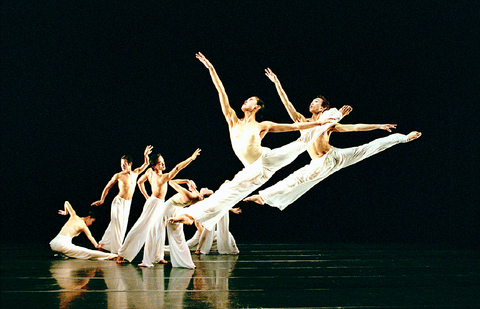This weekend Taipei National Arts University's Focus Dance Company (
This year's set of performances, titled Creative Image (亮相), represents a new beginning for the company composed of the college's dance department students. They have a new name and a new outlook. Last September, when the company flew to South Korea to participate in international competition, the school's president, Qiu Kun-liang (邱坤良), was so impressed by the professional caliber of their performance that he urged them to change their name from Freshmen Dance Company (新鮮人舞團) to something more fitting.
"We were the youngest group there. The president felt that everyone there was focusing on us," said senior company member Wu Jia-sui (

Professional is a good word to describe Focus, whose repertoire includes mostly dances composed by students, some of whom have been with the company for seven years. One such dance is Tian jing sha (天淨沙) composed by Zhang Ya-ting (
The only two pieces in the show not choreographed by students were taught to them by members of world-famous dance troupes.
Water Moon (

PHOTO COURTESY OF FOCUS DANCE COMPANY:
The other highlight piece is Set and Reset/Reset, choreographed by a former member of the Trisha Brown Dance Company, Abigail Yager. The piece is inspired by Set and Reset, the landmark Trisha Brown piece recently recognized by the France's Ministry of National Education as one of the three great masterpieces of 20th-century modern dance.
According to Yager, who came to Taiwan two years ago to be with her husband, the Taiwanese choreographer Yang Ming-long (
Performance notes:
What: Focus Dance Company, Creative Images
When: Tonight at 7:30pm, Saturday at 2:30pm and 7:30pm and Sunday at 2:30pm. Island tour begins on Mar. 16 in Hsinchu.
Where: Taipei National Arts University dance hall (
Getting there: Take the Danshui MRT line to Guandu (
Tickets: NT$300 at the door or through Artsticket outlets: (02) 3393 9888

This is the year that the demographic crisis will begin to impact people’s lives. This will create pressures on treatment and hiring of foreigners. Regardless of whatever technological breakthroughs happen, the real value will come from digesting and productively applying existing technologies in new and creative ways. INTRODUCING BASIC SERVICES BREAKDOWNS At some point soon, we will begin to witness a breakdown in basic services. Initially, it will be limited and sporadic, but the frequency and newsworthiness of the incidents will only continue to accelerate dramatically in the coming years. Here in central Taiwan, many basic services are severely understaffed, and

It is a soulful folk song, filled with feeling and history: A love-stricken young man tells God about his hopes and dreams of happiness. Generations of Uighurs, the Turkic ethnic minority in China’s Xinjiang region, have played it at parties and weddings. But today, if they download it, play it or share it online, they risk ending up in prison. Besh pede, a popular Uighur folk ballad, is among dozens of Uighur-language songs that have been deemed “problematic” by Xinjiang authorities, according to a recording of a meeting held by police and other local officials in the historic city of Kashgar in

The Directorate-General of Budget, Accounting and Statistics (DGBAS) told legislators last week that because the Chinese Nationalist Party (KMT) and Taiwan People’s Party (TPP) are continuing to block next year’s budget from passing, the nation could lose 1.5 percent of its GDP growth next year. According to the DGBAS report, officials presented to the legislature, the 2026 budget proposal includes NT$299.2 billion in funding for new projects and funding increases for various government functions. This funding only becomes available when the legislature approves it. The DGBAS estimates that every NT$10 billion in government money not spent shaves 0.05 percent off

The People’s Republic of China (PRC) was out in force in the Taiwan Strait this week, threatening Taiwan with live-fire exercises, aircraft incursions and tedious claims to ownership. The reaction to the PRC’s blockade and decapitation strike exercises offer numerous lessons, if only we are willing to be taught. Reading the commentary on PRC behavior is like reading Bible interpretation across a range of Christian denominations: the text is recast to mean what the interpreter wants it to mean. Many PRC believers contended that the drills, obviously scheduled in advance, were aimed at the recent arms offer to Taiwan by the